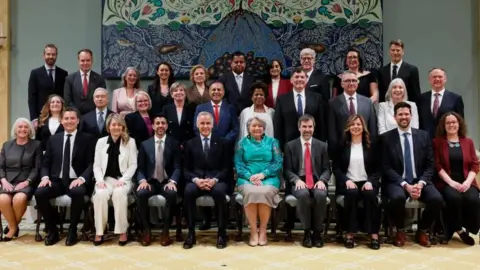In a strategic move aimed at addressing pressing domestic challenges and navigating external pressures, Canadian Prime Minister Mark Carney has recently unveiled his new cabinet, signaling a blend of seasoned leadership and fresh perspectives. This cabinet reshuffle occurs within the context of ongoing trade tensions with the United States, as Carney pledges to enact “decisive action” on his ambitious economic agenda.
The new cabinet comprises 28 ministers and 10 secretaries of state, reflecting significant transformations while retaining familiar figures from previous administrations. A critical addition includes a new foreign minister poised to enhance the US-Canada relationship. Carney emphasized that this cabinet is “purpose-built for this hinge moment,” indicating a focused approach designed to tackle the unique challenges that Canada faces today.
The reshuffle, occurring shortly after the recent election, introduces 24 new faces, including 13 first-time Members of Parliament (MPs). The inclusion of returning veterans from former Prime Minister Justin Trudeau’s government such as Melanie Joly and Chrystia Freeland highlights a balance of continuity and change. While several cabinet members from Trudeau’s era remain, key departments like housing, immigration, and energy, which faced considerable criticism during the previous administration, have been entrusted to first-time ministers, underscoring a potential shift in direction.
Carney’s commitment to maintaining gender parity within the cabinet reflects a continuity of Trudeau’s initiatives toward equal representation. He reiterated that the “new ministry is built to deliver the change Canadians want and deserve,” aiming to instill confidence in the public amid economic uncertainties and trade issues.
Carney’s recent meetings with U.S. President Donald Trump in the White House, following the cabinet announcements, underscored his commitment to renegotiating trade agreements. The cabinet’s new configurations include veteran MP Dominic LeBlanc focusing specifically on Canada-US trade, an essential campaign promise intended to dismantle internal trade barriers. Another significant appointment is Toronto-area MP Maninder Sidhu, assuming the role of minister of international trade.
Additionally, Carney appointed Anita Anand, previously responsible for defense, as the new foreign minister, marking a critical pivot towards fostering international relations. Melanie Joly has now transitioned to oversee industry affairs, while Gary Anandasangaree, moving from justice, will manage public safety, which includes key issues surrounding border security—an area highlighted by Trump as a justification for implementing tariffs.
The reshuffle has not been without controversy, as the departure of key figures like Bill Blair, formerly overseeing defense, and Jonathan Wilkinson, who managed natural resources, drew sharp criticism. Meanwhile, rookie MP Tim Hodgson, who had served as a special advisor to Carney at the Bank of Canada, steps into the role of natural resources, indicating an intent to infuse new energy into that fundamental sector.
Representation across regional and ethnic lines remains a hallmark of Canadian governance, and this cabinet aims to uphold that tradition. Notably, the cabinet includes voices from Canada’s prairie provinces, addressing growing sentiments of alienation from the political centrality of Ottawa.
New ministers like Evan Solomon, serving as minister of artificial intelligence and digital innovation, and Julie Dabrusin, stepping up as environment minister, reflect the forward-thinking initiatives Carney aims to champion. The emphasis on housing is particularly relevant amidst an ongoing affordability crisis, with former Vancouver Mayor Gregor Robertson taking an influential role overseeing housing policy.
Despite the array of new appointments, Conservative leader Pierre Poilievre criticized Carney for retaining numerous ministers from Trudeau’s cabinet, arguing that it contradicts the promise of significant change that Carney had made during his campaign period. This critical observation presents a challenge for Carney as he navigates his administration’s way through complex domestic and international issues while striving to fulfill the expectations of those who supported his vision for Canada’s future.



